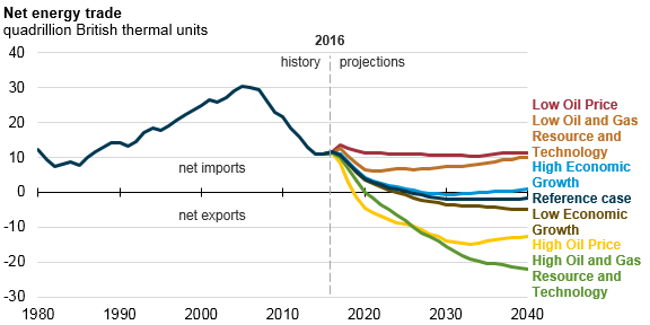EIA’s AEO2017 projects the United States as a net energy exporter in most case
Annual Energy Outlook 2017 (AEO2017), released today by the U.S. Energy Information Administration (EIA), presents updated projections for U.S. energy markets through 2050 based on eight cases (Reference, Low and High Economic Growth, Low and High Oil Price, Low and High Oil and Gas Resource and Technology, No Clean Power Plan implementation). This is the first time that EIA is publishing projections through 2050 in the AEO tables.
The United States becomes a net energy exporter in most AEO2017 cases as petroleum liquid imports fall and natural gas exports rise. Exports are highest, and grow throughout the projection period, in the High Oil and Gas Resource and Technology case, as favorable geology and technological developments combine to produce oil and gas at lower prices. The High Oil Price case provides favorable economic conditions for producers while restraining domestic consumption, enabling the most rapid transition to net exporter status. In all cases but the High Oil and Gas Resource Technology case, which assumes substantial improvements in production technology and more favorable resource availability, U.S. production declines in the 2030s, which slows or reverses projected growth in net energy exports.

“EIA’s projections show how advances in technology are driving oil and natural gas production, renewables penetration, and demand-side efficiencies and reshaping the energy future,” said EIA Administrator Adam Sieminski. “The variation across the analysis cases of projected net energy export levels—as well as other findings in AEO2017— demonstrates the importance of considering the full set of AEO cases.”
Alternative cases incorporate different key assumptions, reflecting market, technology, resource, and policy uncertainties that may affect future energy markets.
Other key findings:
Energy consumption is consistent across all AEO cases, bounded by the High and Low Economic Growth cases. In the Reference case, total energy consumption increases 5% between 2016 and 2040. As a significant portion of energy consumption is related to economic activity, energy consumption is projected to increase by approximately 11% in the High Economic Growth case, over 2016-40, and remain nearly flat in the Low Economic Growth Case. In all AEO cases, the electric power sector remains the largest consumer of primary energy.
Energy production ranges from nearly flat in the Low Oil and Gas Resource and Technology case, to nearly 50% growth over 2016-40 in the High Resource and Technology Case. Unlike energy consumption, which varies less across AEO cases, projections of energy production vary widely. Production growth is dependent on technology, resource, and market conditions. Total energy production increases by more than 20% in the Reference case, from 2016 through 2040, led by increases in crude oil and natural gas production.
Energy related carbon dioxide emissions decline in most AEO cases, with the highest emissions projected in the No Clean Power Plan case. All of the AEO2017 cases except the No Clean Power Plan case include the Clean Power Plan (CPP).
Source: EIA
HEADLINES
- Do shipping markets want Biden or Trump for the win?
- All 18 crew safe after fire on Japanese-owned tanker off Singapore
- Singapore launching $44m co-investment initiative for maritime tech start-ups
- Cosco debuts Global Shipping Industry Chain Cooperation Initiative
- US warns of more shipping sanctions
- China continues seaport consolidation as Dalian offer goes unconditional